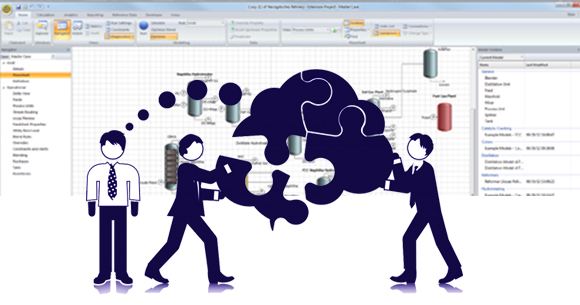SCADA vs. DCS: Differences, Similarities, and Future Convergence

1/21/2022 5:52 PM
Two system control architectures dominate industrial automation: Supervisory Control and Data Acquisition (SCADA) and Distribution Control Systems (DCS). SCADA and DCS systems usually power a range of facilities, including oil refineries, power stations, local water systems, and manufacturing plants. These control systems aim to optimize and safeguard complex operations. However, they also significantly differ in structure, function, and deployment.
In this article, we will discuss the differences between SCADA vs. DCS systems, identify their similarities, and explore the future integration of these two giants toward the success of industrial automation.
SCADA vs DCS: Understanding the Control Structures
The common differentiation between SCADA and DCS systems is that the former operates on a centralized structure while the latter is decentralized. This is a general yet confusing description, so here is a more detailed difference:
Physical Structures
DCS is decentralized because it includes multiple controllers that must be situated close to either the equipment or the subject being controlled. This distribution provides reliability, redundancy, and faster local response.
Centralized SCADA is a server capable of controlling geographically dispersed equipment or subjects. This feature provides efficient resource allocation and unified monitoring and control.
Functionality/Control Flow
DCS: Centralized, despite being physically spread out, DCS is logically centered. They are configured and managed as parts of a cohesive whole through a unified control philosophy.
SCADA: Centralized, all the data from different areas is sent to a central master station. Thus, a single command point drives the operator’s decisions and automated alarms, logically centralizing the system.
Processing Dynamics of SCADA and DCS Systems: Which is faster?
Speed is one of the common concerns when choosing between SCADA vs. DCS. Most literature would conclude that SCADA is faster than DCS. However, “speed” is highly context-dependent
- DCS: It provides deterministic and real-time control. Since its physical structure is near the subject, it can process commands with sub-second precision. Thus, it enables rapid feedback loops and execution of complex control algorithms. For example, if a chemical reactor’s temperature and pressure need adjustment, it reacts quickly.
- SCADA: designed for monitoring, alarm, and supervisory control across multiple sites. It excels in acquiring and visualizing data. However, it typically sends high-level commands that may take seconds to act upon due to communication latency and processing at a central server.
Thus, in SCADA vs DCS, the measure of speed is relative. If the purpose is for local and safety-critical tasks, DCS is dominant. SCADA is advantageous for large-scale data acquisition and operator response.
Data Handling of SCADA vs DCS systems: Real-Time vs. Historized Intelligence
Both SCADA and DCS systems collect data, but they differ in how they process it.
- DCS focuses on real-time data necessary for immediate control decisions. The data lifespan here is often milliseconds to seconds and is used to maintain process stability.
- SCADA specializes in historization and analysis. It logs trends over hours, days, or months. Operators use SCADA data for root cause analysis, regulatory compliance reporting, and performance optimization.
Advanced SCADA systems may also incorporate predictive analytics, machine learning, or interfaces with enterprise resource planning (ERP) systems, extending their role beyond basic supervision.
Shared Industries, Distinct Roles: How SCADA and DCS Work Together
While SCADA and DCS systems are often presented as alternatives, they frequently coexist in industries like power generation, manufacturing, and oil and gas, each serving distinct but complementary functions. Here are some examples of how they work in different industries:
Power Plants
DCS controls precise, time-critical processes such as turbine operation, boiler control, and chemical dosing. These functions involve real-time, local decision-making.
SCADA monitors distributed assets like substations, transformers, and transmission lines across large areas. It centralizes data collection and alerts operators to faults or abnormal conditions.
Manufacturing
DCS – in factories, it manages production lines, process flows, and environmental conditions such as humidity in controlled rooms
SCADA oversees utilities like heating, ventilation, air conditioning, power usage, and water systems. It provides centralized dashboards and long-term data analysis.
Oil and Gas
DCS controls the refinery units, such as the distillation columns, reactors, heat exchangers, and pumping systems. DCS also ensures safety interlocks, such as shutdown equipment, closed valves, and trigger alarms.
SCADA manages remote wellheads, pipelines, and offshore platforms. It monitors leaks, pressure drops, and flow rates from afar.
Blurring Boundaries of SCADA vs DCS System: A Future Convergence
Traditionally, choosing between SCADA and DCS is complicated. As explained, DCS manages precise, real-time control within a facility, while SCADA handles remote monitoring. Today, advancements in automation are blurring these roles.
Modern DCS systems now include features that were previously exclusive to SCADA, such as
- Centralized Human-Machine Interface (HMI)
- Data Historization
- Integrated Dashboards
At the same time, SCADA platforms have evolved with:
- Edge Computing, enabling some local control
- Modular scalability, allowing for more complex operations.
These changes mean SCADA is not just for high-level monitoring anymore—it can now perform limited automation tasks. Meanwhile, DCS provides both control and supervisory insight.
The result is a growing trend toward hybrid systems that combine the strengths of both SCADA and DCS systems. This approach supports real-time process control and remote system-wide visibility in a unified architecture.
MAKING SENSE OF SCADA VS DCS: WHAT’S NEXT FOR YOU?
The discussion around SCADA vs DCS systems has moved beyond simple comparisons. In today’s complex industrial environments, it’s about understanding how SCADA and DCS systems can work together, each playing a vital role in achieving operational excellence. DCS delivers fast, local control for intricate, safety-critical processes, while SCADA ensures visibility, coordination, and informed decision-making across remote assets.
As technology evolves, so does the relationship between these systems. The modern SCADA vs DCS system is no longer a choice of one over the other but a strategic blend supporting depth and scale. Integrating SCADA and DCS systems effectively could be the key to greater efficiency, agility, and resilience, whether in energy, manufacturing, water treatment, or critical infrastructure.
EXPLORE THE RIGHT FIT: SCADA VS DCS IN ACTION
We understand that navigating these choices can feel overwhelming. We’re here to help you cut through the complexity and make confident, future-ready decisions.
Looking to understand your options with SCADA vs DCS better?
Connect with our team today or explore our expert resources. Let us guide you toward a solution tailored to your unique goals with the clarity, support, and insight you deserve.
Recent Posts
Socials




